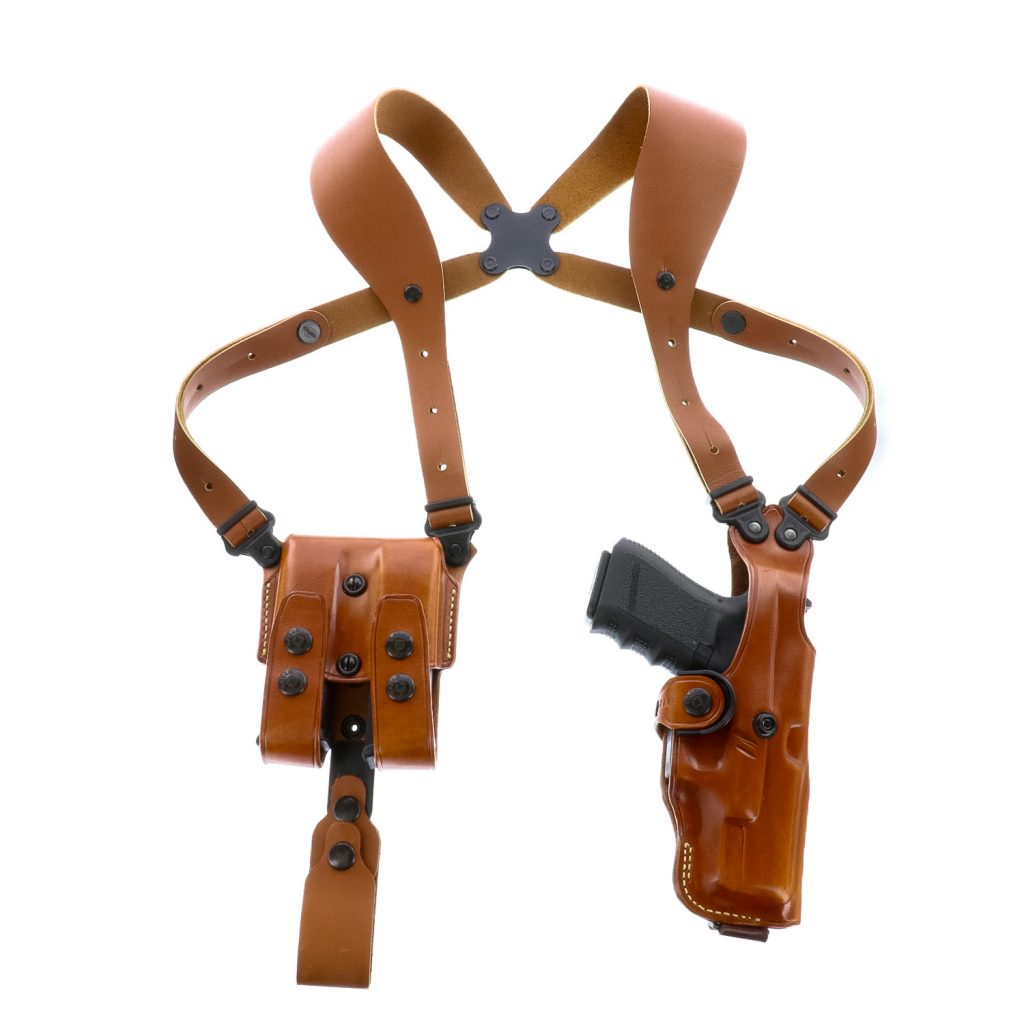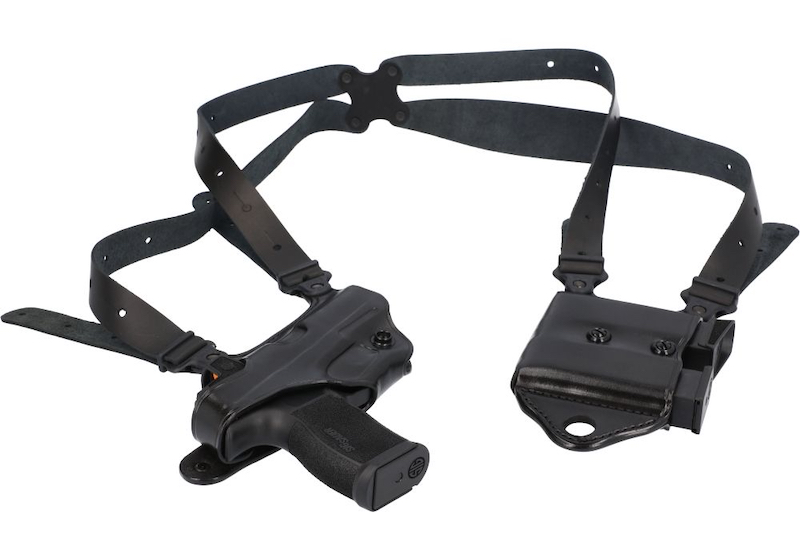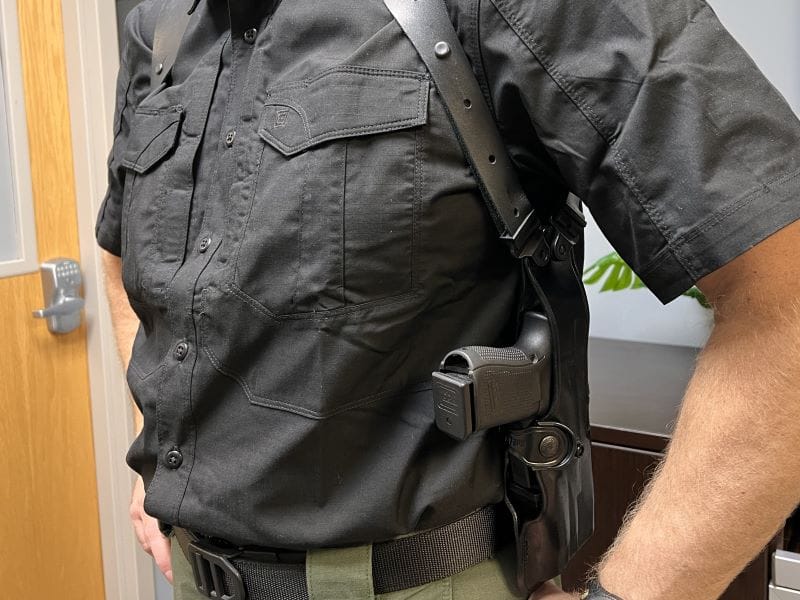Shoulder holsters are just cool. I’m not saying cool is a practical factor in choosing a holster, but come on, it’s awesome. Elliot Ness, Sonny Crockett, and Dirty Harry can’t be wrong. Shoulder holsters have an interesting history that goes back far enough that Doc Holiday supposedly wore one. They’ve come in and out of fashion depending on the current culture, but regardless of their popularity, they’ve remained as constant as OWB, IWB, and most other holster types. Let’s dig into shoulder holsters and break down everything you need to know.
1. Comfort
You want a well-made and designed shoulder rig. The Galco Miami 1 and 2 are my favorite options. The spider harness in the back allows for good freedom of movement and superior comfort. The design uses quality leather that isn’t abrasive and painful after a full day of carrying. It’s adjustable to an extreme degree and creates a very comfy experience altogether.

While I put comfort first, it’s admittedly one of the lowest factors in choosing a holster. I put it first for shoulder holsters, so I can go ahead and say you get what you pay for. That phrase encapsulates shoulder holsters perfectly. Cheap shoulder holsters aren’t good shoulder holsters. They’ll beat you up and leave you feeling like you’re carrying a box of rocks on your back.
2. Access
Shoulder holsters are slower than most belt options, just based on the amount of movement required to reach the gun and then get it on target. That’s just the nature of the beast. You should and can train to reduce this time as much as possible, but it will never be as fast as a quality appendix holster or even strongside IWB.

Access to a gun in a shoulder holster can be tricky, but there are times when it’s better than belt options. If you are going to be seated for long periods of time, then a shoulder holster can be easier to access, especially if your chair of choice has hand and armrests. For a big guy like me, a shoulder holster is way easier to access than a belt holster while driving.
This is especially true in anything outside of an F250. The door and center console of modern cars often makes it tough for me to reach the big iron on my hip, but not the big iron under my arm.
3. Safety
Remember when I said you get what you pay for? A generic nylon shoulder holster doesn’t offer the same safety as a properly molded holster. Galco, for example, uses a molded leather holster, as do most quality companies. The benefit here is that a properly molded holster fits the contours of your gun and ensures the trigger is protected. Noting can get through the holster and into the trigger, and the holster itself won’t pull the trigger.
4. Concealment
Concealment with a shoulder holster can be tricky. Unlike belt-mounted rigs, a simple T-shirt simply won’t do it. You need a dedicated cover garment in the form of a button-down overshirt or jacket. It works well in suits and in winter clothing, but admittedly in a Florida summer, it’s tough to deal with. Admittedly, concealment can be tricky during certain parts of the year, and this can be a deal breaker.
Quality matters, and it matters in nearly every factor with a shoulder holster. When it comes to concealment, you are relying on straps to hold the holster in defiance of gravity. If those straps break or loosen, then you’ll be compromising concealment, and that’s not the goal, right?

5. Drawing
Drawing from a shoulder holster takes a proper technique. You have to clear your cover garment while also bringing your nondominant hand up and out of the way. When you draw from a shoulder holster, it’s very easy to flag yourself, and no one wants to point a loaded gun at their brachial artery.
In a training environment, this can create issues on the firing line. Drawing from a shoulder holster creates an issue with flagging other shooters on the line. This same issue can translate to the real world and must be present in the concealed carrier’s mind when toting and training with a shoulder holster.

6. Orientation
Shoulder holsters come in several orientations. The most popular is horizontal. This orients the entire gun with your body and has the barrel pointing rearward. It’s the most popular choice and also the fastest to draw. It works well with compact-sized pistols and smaller ones. You have to be a fairly large guy to conceal a service-sized pistol in this method.
The second most popular is vertical. This orientates the barrel downward. This method maximizes concealment and makes it easy to carry a full-sized service handgun. The draw is slightly slower due to more complicated movements.
Lastly, there is also an upside-down orientation. This orients the barrel to the sky. This method has fallen out of favor, and having the gun pointed in a direction pretty close to your head seems like a silly idea. This seemed to be isolated to J-frame revolvers and has long passed out of vogue.
7. Retention
Retention with a shoulder holster requires you to use an active retention device. The fact the holster can swing and move as the torso bends back and forth can create issues with anything outside of an active retention design. This is often in the form of a leather thong secured by a button. It’s not the only option, but an active retention device is absolutely necessary.

8. Accessories and Modularity
Many shoulder holsters have modular designs. They allow you to add an accessory on the side that’s not carrying the gun. The most common is a magazine pouch. They often hold a couple of magazines, and they act as a good counterbalance to the gun. A magazine pouch isn’t the only option, though. Everything from handcuffs to knives can be mounted depending on the holster.

Another accessory is tie-downs. Tie-downs attach to your holster and spare mag pouches and can then attach to your belt to better secure the shoulder rig. If you plan to run with the holster, they are a must-have to avoid getting your ribs beat up. They can help ensure your weapon remains comfortable, especially with a heavier firearm and a more active lifestyle.
Shoulder Rigs
Like every other holster on the market, the shoulder rig has its strengths and weaknesses. It’s a little outside of the norm and has its own challenges and advantages. Like any good rig, you need to practice, train, and consistently carry. The shoulder holster doesn’t have to be your only holster. Like anything else, it’s a tool in the box.

